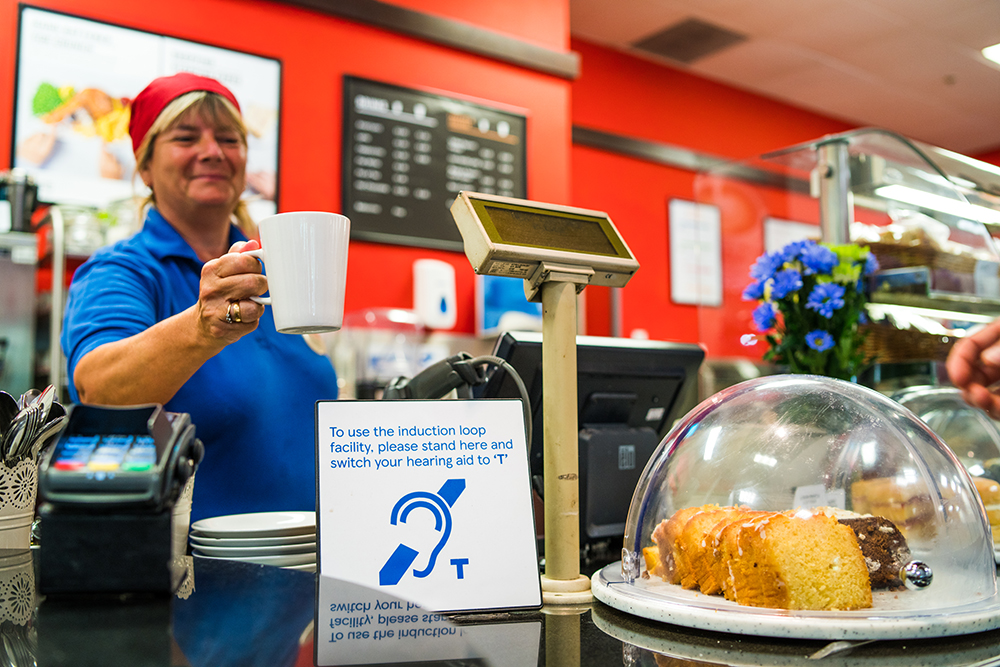
07 May A ‘Right to Hear’
11 million people (1 in 6) in the UK live with hearing loss. They constitute the largest disabled group and almost a quarter of them wear a hearing aid.
This quick reference guide has been produced for Deaf Awareness Week 2019.
It sets out your responsibilities as a service or business with premises accessible to the public and the assistive listening technology that can help you to meet those responsibilities.
Legal requirements and best practice
The Equality Act 2010 states that everyone should be treated equally. Public buildings are required to make “reasonable adjustments” to allow people with hearing loss to access venues and services.
What constitutes a “reasonable adjustment” depends on the size of the organisation, the costs involved and how practical it would be to make the changes.
The Act requires service providers such as banks to provide information in an accessible format to everyone, so a hearing loop at a banking counter would be a “reasonable adjustment.”
“It’s like being the one sober person at a party where everybody else is enjoying themselves. It ranges from sometimes just wanting to cry through to utter rage.”
Maureen’s experience of the theatre with hearing loss
Part M of building regulations provides premises with guidance for making sure everybody can access and use buildings and their facilities.
The revised British Standard 8300 (January 2018) represents best practice for making buildings inclusive and accessible. For the first time, it now includes recommendations for where assistive listening technology should be provided.
Read more on legislation by clicking here.
Only 1 in 10 shops provide hearing loops for customers with hearing aids
The role of assistive listening technology
More than 2.5 million people with hearing loss wear a hearing aid. These amplify all sound making it difficult for wearers to distinguish the speech or music they want to hear.
Assistive listening technology enables users to hear sound sources directly by cutting out background noise.
Hearing Loops – Sound is picked up through a microphone, converted to magnetic impulses by the loop ‘driver’ and transmitted via a loop aerial which is often embedded into a floor or laid beneath tiling or carpets. When a user switches their hearing aid to the ‘T’ position it converts this signal back to the original sound.
Infrared Systems – Infrared systems use light to transmit audio signals to receiver units. This technology is ideal for spaces where confidentiality is required, such as conference rooms, police stations and courtrooms.
Radio Frequency Systems – Radio waves are not obstructed by walls, glass or other obstacles and can be transmitted over large areas. These systems can also be used for multiple language presentations on guided tours.
Speech Transfer Systems – Microphones that amply speech at a secure window should have built-in hearing loops so customers with a hearing device can hear the staff member clearly
Planning an installation
Every tender, refurbishment project and new build should incorporate some form of assistive listening technology. Plan it in at the earliest stage with specialist advice to minimise costs and maximise performance.
A specialist installer will consider:
Room size and construction – How much power is needed? Will metal loss affect the signal strength?
Room usage – Does it need blanket coverage or a number of listening areas? Does sound need to be contained for confidentiality?
Fixtures and fittings – Power sources such as air conditioning systems can cause interference. Visual barriers may block signage or passengers using a listening area may not be able to see departure boards
Once a system has been installed, regular testing and maintenance is essential. Make sure it is turned on, is working and that staff are trained to use it.
Why it matters
The number of people with hearing loss is expected to reach 15.6 million by 2035. That’s 1 in 5 of the population.
For retailers, the leisure industry, consumer banking services and transport operators there is an obvious business case for enhancing communication, both in terms of income and reputation.
Three out of four people with disabilities have walked away from businesses due to a lack of disability awareness and poor service.
For employers and facilities managers, managing hearing loss is a welfare issue, with those affected 2.5 times more likely to develop depression. Unsupported, employees’ performance may be affected. Their safety may also be compromised if they can’t hear emergency alarms or announcements clearly.
Ultimately, providing assistive listening technology and improving people’s ability to communicate has benefits for everyone concerned.
Speak to us about finding a solution that’s right for you. Contact us on 01732 223900 or sales@contacta.co.uk.
To download a PDF version of this guide, click here.

 MADE IN THE UK: We’re proud to say our Contacta designed products are manufactured in the UK
MADE IN THE UK: We’re proud to say our Contacta designed products are manufactured in the UK